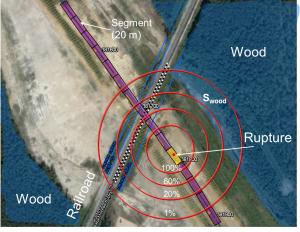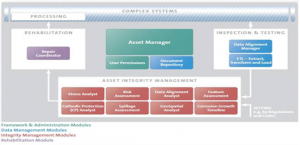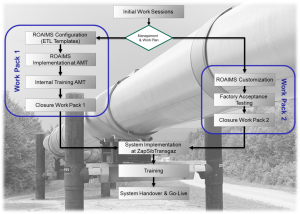August 2014, Vol. 241, No. 8
Features
Why Manufacturers Oppose Unfettered LNG Exports

The Ukraine-Russia crisis has Congress rushing to consider monumental changes to accelerate exports of LNG that will permanently and negatively affect the U.S. natural gas market, due to high OPEC cartel crude oil-linked LNG prices, driving export demand.
The knee-jerk reaction has unsettling consequences for manufacturing industries that depend upon affordable natural gas and power – but in fact, it will also substantially raise costs for all consumers and have detrimental effects to the economy long-term. Cartels are un-American and the antipathy of free markets; public policymakers should not let the U.S. market be influenced by them.
The debate has energy-intensive, trade-exposed (EITE) manufacturing companies urging Washington to find a middle ground – one that allows for some LNG exportation, but not so much that competitiveness and jobs will be damaged. Manufacturers do not want the United States to repeat the mistake the Australian government made by supporting unfettered building of LNG export terminals.
Australia: A Cautionary Tale
What happened to Australia can happen in the United States with time. Both countries are endowed with vast natural gas resources and both are producing at record levels. What is different is that Australia started exporting LNG in 1989, and continues to increase export capacity, which has tripled its domestic price of natural gas to an equivalent of about $9 MMBtu (wholesale price on the East Coast of Australia). This price is expected to rise to $11-12 MMBtu next year as new export terminals begin to ship.
In Australia, domestic consumers are expected to pay the OPEC cartel crude oil-linked LNG Asian “netback” price, or they will not get the gas. The netback price is the price of LNG in places like Japan and China, which is about $16 MMBtu, less the costs of liquefaction and transportation between those countries and Australia. For example, $16 MMBtu of gas in China, minus $4-5 MMBtu liquefaction and transportation costs, “nets back” to Australia at $11-12 MMBtu. That is the price Australian consumers anticipate they will pay next year.
Australian manufacturers are closing their doors and power companies and industries are taking action to switch from natural gas to coal. The cost of home heating and cooling has soared. Homeowners’ heating and cooling bills have increased 17%, effective July 1, 2014.
Domestic consumers are suffering because Australian public policymakers failed to take care of the people who have entrusted them to represent their interests. This has turned Australia’s natural gas from a strategic asset to a liability for domestic consumers.
The Australian government has handed a sovereign resource over to the control of a small number of global oligopolies. Now, the nation recognizes it has a problem, but it is too late to do anything that does not require drastic political action – which politicians are loath to do. Very few permanent jobs are created from these exports and Australians are essentially subsidizing the natural gas resource owners into a higher price regime.
Undoubtedly, the Australian government expected that supply would keep up with the demand imposed by LNG exports. Wrongfully, this same assumption underlines the thinking of U.S. LNG export advocates.
LNG export proponents gloss over the reality that U.S. natural gas production is highly regulated and affected by state and federal regulations and public opinion that can change quickly. Depending upon who is running state and federal governments, regulations and moratoriums can greatly affect production and demand.
On production, questions remain about what the EPA will do to regulate hydraulic fracturing, while individual states either have or are taking action in several ways that deter production. On demand, one only needs to look at EPA’s regulatory actions to stop coal use, regulate GHGs and impose new tough ozone standards to gain an understanding of what might lie ahead.
It Can Happen Here
With time, the same thing that has happened to Australian consumers can happen in the United States. The U.S. netback price is $16 MMBtu, less about $6 MMBtu for liquefaction and transportation costs, or about $10 MMBtu. This means that LNG exports can eventually drive U.S. prices to at least $10 MMBtu before they are equivalent to the Asia prices, then the United States will have lost its advantage.
It is interesting and troubling, that the U.S. Department of Energy’s (DOE)-sponsored NERA LNG report said this is exactly what would happen if as we increased exports. The NERA report said U.S. LNG exports would reduce wages and disposable income, increase energy prices, curb investment in the U.S. economy (less investment in manufacturing), and that owners of the resource base would benefit. Said another way, owners of the natural gas resource will benefit, while the vast the majority of people in the country will lose economically.
Free Market
The United States is the largest natural gas market in the world. And, it is a “free market” in which supply and demand determine the price. OPEC crude oil-linked LNG prices, on the other hand, are not a “free market.” OPEC learned a long time ago that market power permits it to extract higher rents (prices), and non-OPEC LNG Australian suppliers have conveniently supported this pricing structure that keeps LNG prices higher than they would be otherwise.
There is no excuse for U.S. public policymakers to succumb to OPEC cartel LNG pricing as the driver for U.S. LNG exports. Existing federal statutes under the Natural Gas Act, if executed properly, provide for a public interest determination (PID) test to determine whether the public will be helped or hurt by approving an application to export LNG for shipment to non-free trade countries. Manufacturers support the statute and the PID test as a public policy safeguard in order to hopefully find a balance between LNG export volumes and protecting U.S. consumers.
However, the Obama administration has failed to adequately exercise its responsibilities in several ways. It has failed to define a transparent process for decision-making. Instead the administration has used an old rule designed for imports of LNG, striking out the word “imports” and replacing it with “exports.” The two could not be more different. Imports reduce risks to consumers – while exports increase risks.
The existing process is mostly non-transparent and places the burden on the consumer to prove that exports will not damage prices. Finally, the two DOE LNG studies used flawed assumptions and underestimate the impact of LNG exports on the nation. This is especially true of the portion of the NERA study that addressed EITE industries which used inaccurate information that underestimates the effect of LNG exports on industry.
Shifting Risks
EITE companies warn that LNG export demand creates new challenges and risks for domestic consumers. Approval of LNG export terminals are for periods of 20-30 years and a lot can happen to either domestic demand or supply that cannot be anticipated today. Once an export terminal has been approved, there is no putting the genie back in the bottle.
Because of OPEC cartel-structured pricing, LNG buyers are relatively “price-insensitive” and will “buy-it-away” from domestic consumers. Also, most of the large LNG-buying countries are located in the northern hemisphere. This means buying LNG during the winter peak-heating season when we need it the most, pulling down inventories and consuming pipeline capacity, competing with domestic consumers and increasing peak prices for both natural gas and electricity. Under every scenario, it is the U.S. consumer who, unfortunately, will absorb the entire risk of LNG export uncertainties.
Operating Costs
Not all manufacturers have LNG export concerns because energy is not a large portion of some manufacturers’ operating cost. However, for EITE industries, a large subset of the manufacturing sector, energy – as a fuel or feedstock – can represent 20-85% of operating costs. EITE companies include chemical, plastics, nitrogen fertilizer, integrated steel, recycle steel, iron ore, aluminum, pulp and paper, glass, industrial gases, cement, food processing and refining operations. Relatively small changes to the price of natural gas or gas-fired power can have significant effects to competitiveness.
For perspective, the manufacturing sector uses 28.7% of U.S. natural gas and 22% of all U.S. energy. The EITE industries consume over 81.6% of the energy used by the entire manufacturing sector. For EITE industries, energy and capital are the primary costs.
EITE industries do not want a repeat of the 2000-2008 escalation of natural gas prices that peaked in 2008 at $9.65 MMBtu. During this time, manufacturing competitiveness faltered, while tens of thousands of factories closed and more than 3 million manufacturing job were lost. To be fair, there were other factors that contributed to job losses, but for EITE industries, natural gas was the number one culprit.
U.S. As Largest Exporter
Of deep concern is the DOE’s approval and conditional approval of LNG export volumes of 4 Tcf, a 15.4% increase over 2013 U.S. demand; this is a volume greater than Qatar, the world’s largest LNG exporter. However, unlike the United States, Qatar does not have a large manufacturing sector that is price-sensitive and competes globally. Exporting large amounts of LNG puts 12 million direct jobs and the 5.2 million indirect jobs in the U.S. manufacturing sector at risk.
Much has been said about the significant and affordable natural gas resources we have as a country. Why then is the Henry Hub price forecasted to rise 134.5% by 2025, compared to 2012 (Figure 1), according to the U.S. Energy Information Administration (EIA)?
Importantly, the EIA forecast only includes 2.72 Tcf of the 4 Tcf of LNG exports that has already been approved by the DOE for shipment to non-free trade countries. In fact, the actual 2025 price will likely be much higher because EIA has not included the full impact of the retirement of 50,000-60,000 MW of coal-fired electric generators due to the mercury maximum achievable control technology (MACT) and the industrial boiler MACT guidelines, the EPA-proposed greenhouse gas (GHG) rule, and the anticipated lower ozone standard, all of which will increase demand for natural gas.

The Bureau of Labor Statistics data shows monthly job changes (Figure 2) for the oil and gas industry since 2007. From 2010-2013, even though production has significantly increased, only 59,527 oil and gas jobs have been created. This speaks loudly to the LNG export issue. It implies that even if there are significant LNG exports, relatively few U.S. jobs will be created.
Manufacturing, on the other hand, increased 568,108 jobs from 2010-2013. It is in the consumption of low-cost natural gas and electricity where the United States can maximize job and economic growth (Figure 3).

A 2013 study by Charles Rivers Associates adds further confirmation of these findings. The study compared the economic contributions of exporting 5 Bcf/d of LNG vs. using the same amount of natural gas in manufacturing. The comparison makes clear that using natural gas in manufacturing creates superior benefits to the U.S. economy (Figure 4).

Volume Growth
Industrial Energy Consumers of America has a Natural Gas Supplier Council that gets together at least twice a year to discuss public policy issues. Privately, we find that most natural gas producers would rather sell their gas in the United States than have it exported. What they care about is volume growth and they hope the domestic markets can deliver it.
The prospects are very bright. The EIA Annual Energy Outlook 2014 net demand forecast (domestic demand and net export/imports) foretells a 17.3% increase from 2013-2020. Industrial demand is expected to increase by 8.4%. A July 2014 study from the Center for Energy Economics said that just the 103 industrial projects that are likely to be built in Texas and Louisiana could increase natural gas demand by 23.5 Bcf/d.
Natural gas is not a renewable resource and the cost curve rises from here. These resources provide a once-in-a-lifetime treasure upon which to build our economy and the manufacturing sector for future generations. Let’s not waste this opportunity to generate a lasting economic recovery with high paying value-added manufacturing jobs by failing to act to protect the nation from the OPEC cartel LNG pricing structures.
Author: Paul Cicio has been president of the Industrial Energy Consumers of America (IECA) since its founding 13 years ago. IECA is a nonpartisan association of leading manufacturing companies with $1 trillion in annual sales and more than 2,900 facilities nationwide.





Comments